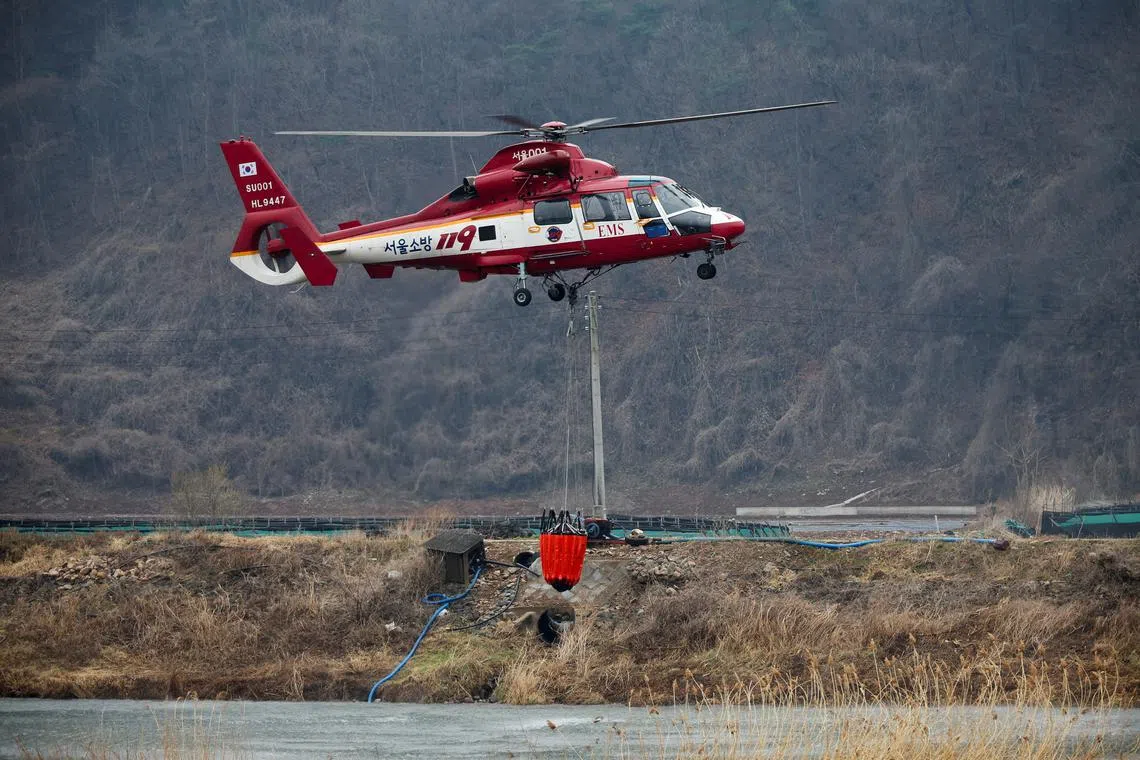South Korea hopes to use break in weather to contain deadly wildfires
Sign up now: Get insights on Asia's fast-moving developments

Firefighting operations continued as a wildfire burned in Yeongyang, south-eastern South Korea, on March 28.
PHOTO: REUTERS
Follow topic:
ANDONG, South Korea – Light rain offered some relief to South Korean authorities tackling the country’s worst wildfires on record, with exhausted firefighters making another push on March 28 to contain blazes stretching 70km.
At least 28 people have died and more than 45,000ha of largely forest land in the south-east have been charred or are burning, as strong winds have driven blazes from central Uiseong county to coastal regions over the past week.
“Conditions are very good, and we have a chance, so we’re deploying all available resources to try to contain the main fires today,” Korea Forest Service Minister Lim Sang-seop told a media briefing.
Uiseong reported that fires had been put out in 95 per cent of the area as of early March 28. Flames in 85 per cent of neighbouring Andong city, which is home to Unesco World Heritage sites, have been doused, according to the Korea Forest Service.
Yeongdeok county on the east coast, where the fire spread from the initial blaze more than 70km away in under 12 hours, was still fighting to contain the flames, with nearly a third of the area still ablaze.
Light rain of less than 3mm fell in some parts of the regions on March 27 and offered “a little help”, forest service spokesman Kim Jong-gun said.
Firefighters and helicopters were taking advantage of more favourable weather and better visibility to make a push for more progress before winds were expected to pick up later on March 28, he said.
The blazes that began in Uiseong have become the biggest single forest fire in South Korea’s history
More than 80 helicopters started flying at daybreak on March 28 to dump water, the safety ministry said. South Korea relies on helicopters to fight forest fires because of its mountainous terrain. A helicopter pilot died on March 26 after crashing while trying to tackle a blaze.
Poor visibility, partly due to smoke, and strong winds prevented many helicopters from flying at times on March 26 and 27. They are also not used after dark.
North Gyeongsang province’s governor Lee Cheol-woo said the ferocity of the blaze and the conditions that fuelled it showed that the “current forest fire response must be completely overhauled”.
He cited how even boats moored in the sea were not safe from the flames, with showers of embers setting 12 vessels ablaze. Mr Lee called for South Korea to consider using larger fixed-wing aircraft to help douse fires.
Experts have said the Uiseong fire showed extremely unusual spread in terms of its scale and speed, and that climate change is expected to make wildfires more frequent and deadly globally.
A forest service official has said satellite imagery analysis showed the fire travelled at 8.2m per second at its peak, equivalent to the pace of an average adult running.
The wildfires have displaced more than 30,000 residents, many of whom are elderly, and ravaged everything in their path, including historic temples and homes, in the mountainous forest regions of North Gyeongsang province. REUTERS

